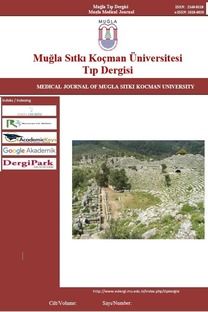Dijital Sinir Tamir Sonuçları ve Etkileyen Faktörler
Dijital Sinir, İyileşme, Tamir
Digital Nerve Repair Results and Affecting Factors
Digital Nerve, Recovery, Repair,
___
- 1. Lohmeyer JA, Sommer B, Siemers F, Mailänder P. Nerve injuries of the upper extremity-expected outcome and clinical examination. Plast Surg Nurs. 2009;29(2):88-93.
- 2. Herndon JH. Neuromas. In: Green DP. Green’s Operative Hand Surgery. 1988; 1405-1423. 4th Ed. New York: Churcill-Livingstone.
- 3. Pedretti LW, Early MB. Occupational therapy practice skills for physical dysfunction, 5th Ed. St. Louis: Mosby, 2001.
- 4. Efstathopoulos D, Gerostathopoulos N, Misitzis D, Bouchlis G, Anagnostou S, Daoutis NK. Clinical assessment of primary digital nerve repair. Acta Orthop Scand Suppl. 1995;264(23):45–7.
- 5. Bulut T, Akgun U, Ozcan C, Unver B, Sener M. Inter- and intra-tester reliability of sensibility testing in digital nerve repair. J Hand Surg Eur Vol. 2016;41(6):621-3.
- 6. Young L, Wray RC, Weeks PM. A randomized prospective comparison of fascicular and epineural digital nerve repairs. Plast Reconstr Surg. 1981;68(1):89-93.
- 7. Calcagnotto GN, Braga Silva J. The treatment of digital nerve defects by the technique of vein conduit with nerve segment. A randomized prospective study. Chir Main. 2006;25(3-4):126-30.
- 8. Wang WZ, Crain GM, Baylis W, Tsai TM. Outcome of digital nerve injuries in adults. J Hand Surg Am. 1996;21(1):138-43.
- 9. Weinzweig N, Chin G, Mead M, et al. Recovery of sensibility after digital neurorrhaphy: a clinical investigation of prognostic factors. Ann Plast Surg. 2000;44(6):610-7.
- 10. Cheng AS, Hung L, Wong JM, Lau H, Chan J. A prospective study of early tactile stimulation after digital nerve repair. Clin Orthop Relat Res. 2001;(384):169-75.
- 11. Kallio PK. The results of secondary repair of 254 digital nerves.J Hand Surg Br. 1993;18(3):327-30.
- 12. Dellon AL, Mackinnon SE, Crosby PM. Reliability of two-point discrimination measurements. J Hand Surg Am. 1987;12(5):693-6.
- 13. Mailänder P, Berger A, Schaller E, Ruhe K. Results of primary nerve repair in the upper extremity. Microsurgery. 1989;10(2):147-50.
- 14. Novak CB, Mackinnon SE, Kelly L. Correlation of two-point discrimination and hand function following median nerve injury. Ann Plast Surg. 1993;31(6):495-8.
- 15. Efstathopoulos D, Gerostathopoulos N, Misitzis D, Bouchlis G, Anagnostou S, Daoutis NK. Clinical assessment of primary digital nerve repair. Acta Orthop Scand Suppl. 1995;264:45-7.
- 16. Altissimi M, Mancini GB, Azzarà A. Results of primary repair of digital nerves. J Hand Surg Br. 1991;16(5):546-7.
- 17. Chaise F, Friol JP, Gaisne E. Results of emergency repair of wounds of palmar collateral nerves of the fingers. Rev Chir Orthop Reparatrice Appar Mot. 1993;79(5):393-7.
- 18. Risitano G, Cavallaro G, Merrino T, Coppolino S, Ruggeri F. Clinical results and thoughts on sensory nerve repair by autologous vein graft in emergency hand reconstruction. Chir Main. 2002;21(3):194-7.
- 19. Sullivan DJ. Results of digital neurorrhaphy in adults. J Hand Surg Br. 1985;10(1):41-4.
- 20. Mermans JF, Franssen BB, Serroyen J, Van der Hulst RR. Digital nerve injuries: a review of predictors of sensory recovery after microsurgical digital nerve repair. Hand (N Y). 2012;7(3):233-41.
- 21. al-Ghazal SK, McKiernan M, Khan K, McCann J. Results of clinical assessment after primary digital nerve repair. J Hand Surg Br. 1994;19(2):255-7.
- 22. Berger A, Millesi H. Nerve Grafting. Clin Orthop Relat Res. 1978;(133):49-55.
- 23. Rinker B, Liau JY. A prospective randomized study comparing woven polyglycolic acid and autogenous vein conduits for reconstruction of digital nerve gaps. J Hand Surg Am. 2011;36(5):775-81.
- 24. Portincasa A, Gozzo G, Parisi D, et al. Microsurgical treatment of injury to peripheral nerves in upper and lower limbs: a critical review of the last 8 years. Microsurgery. 2007;27(5):455-62.
- 25. Rinker B, Fink BF, Barry NG, et al. The effect of cigarette smoking on functional recovery following peripheral nerve ischemia/reperfusion injury. Microsurgery. 2011;31(1):59-65.
- 26. Segalman KA, Cook PA, Wang BH, Theisen L. Digital neurorrhaphy after the age of 60 years. J Reconstr Microsurg. 2001;17(2):85-8.
- 27. Seddon H. Surgical Disorders of Peripheral Nerve. 2nd Ed. London: Churchill Livingstones, 1975.
- 28. Birch R. Primary and Secondary Repair of Divided Peripheral Nerves. Smith Operative Surgery; The Hand .4th Ed. London: Butterworhts, 1984.
- 29. Weber RA, Breidenbach WC, Brown RE, Jabaley ME, Mass DP. A randomized prospective study of polyglycolic acid conduits for digital nerve reconstruction in humans. Plast Reconstr Surg. 2000;106(5):1036-45.
- 30. Walton RL, Brown RE, Matory WE Jr, Borah GL, Dolph JL. Autogenous vein graft repair of digital nerve defects in the finger: a retrospective clinical study. Plast Reconstr Surg. 1989;84(6):944-52.
- ISSN: 2148-8118
- Yayın Aralığı: Yılda 3 Sayı
- Başlangıç: 2014
- Yayıncı: Muğla Sıtkı Koçman Üniversitesi
İdiyopatik İnflamatuar Medial Meatal Fibrozis: Olgu Sunumu Ve Kısa Literatür Derlemesi
Gamze ÖZTÜRK, Erdem Atalay ÇETİNKAYA, Ömer Tarık SELÇUK, Gökhan YILMAZ, Özer Erdem GÜR
Özcan DERE, Cenk YAZKAN, Okay NAZLI
Sistemik İnflamatuar Belirteçlerin Hyperemezis Gravidarum Tanısındaki Rolü
Süleyman Cemil OĞLAK, Mehmet OBUT
Adli Tıp Polikliniğinde Adli Rapor Düzenlenen Çocuk Hastaların Değerlendirilmesi
Burcu ERSOY, YASEMİN BALCI, Yeşim GÖK, ÜMİT ÜNÜVAR GÖÇEOĞLU
Özgür TANRIVERDİ, Kerim Kaan SANDAL, Sedef ATEŞ, Selçuk UYLAŞ, Hatice DUMAN, Ayşe Ferhan AKGÜL, Ali ALKAN
ÖZGÜR TANRIVERDİ, Kerim Kaan SANDAL, Sedef ATEŞ, Selçuk UYLAŞ, Hatice DUMAN, Ayşe Ferhan AKGÜL, Ali ALKAN
Akut Kolesistit Tanısında Kan Parametreleri ve Türevlerinin Tanı Koymadaki Etkinliği
Levent ŞAHİN, HÜSEYİN FATİH GÜL, Turgut DOLANBAY, Mustafa MAKAV, Murat ARAS
Saçlı Hücreli Lösemi Tedavisinde Kladribinin Prognoza Etkisi
Senem MARAL, Murat ALBAYRAK, Hacer Berna AFACAN ÖZTÜRK, Abdulkerim YILDIZ, Pınar CÖMERT, Buğra SAĞLAM, Mesut TIĞLIOĞLU, Merih Reis ARAS
